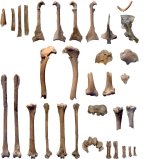Fred Ruhe
Well-known member

Gerald Mayr & Andrew C. Kitchener, 2023
A new fossil from the London Clay documents the convergent origin of a “mousebird-like” tarsometatarsus in an early Eocene near-passerine bird
Acta Palaeontol. Pol. 68 (X): xxx–xxx, 202
Abstract and free pdf: https://www.app.pan.pl/archive/published/app68/app010492022.pdf
We describe a partial skeleton of a small bird from the lower Eocene London Clay of Walton-on-the-Naze (Essex, UK), which shows close affinities to two phylogenetically controversial early Paleogene taxa, Morsoravis sedilis (lower Eocene of Denmark) and Pumiliornis tessellatus (lower/middle Eocene of Germany). Our phylogenetic analysis supports a clade including M. sedilis, P. tessellatus, and the new species, Sororavis solitarius gen. et sp. nov., and this clade is introduced as Morsoravidae fam. nov. Even though morsoravids resulted within crown group Psittacopasseres in our analysis, as the sister taxon of the Zygodactylidae and Passeriformes, they exhibit a presumably plesiomorphic tarsometatarsus morphology unlike that of zygodactyl psittacopasserines. The elongate tarsometatarsus of S. solitarius shows a resemblance to that of extant mousebirds (Coliiformes) and has a large trochlea for the second toe, which bears an extensive trochlear furrow. This distinctive foot morphology is likely to represent an adaptation for a grasping foot and may indicate a locomotory behaviour similar to that of mousebirds, which are arboreal acrobats that forage in the foliage of trees and shrubs. Since the Psittacopasseres and the Coliiformes are widely separated in current phylogenies, the “mousebird-like” tarsometatarsus of the new species represents a notable instance of convergent evolution in small arboreal birds.
Enjoy,
Fred
A new fossil from the London Clay documents the convergent origin of a “mousebird-like” tarsometatarsus in an early Eocene near-passerine bird
Acta Palaeontol. Pol. 68 (X): xxx–xxx, 202
Abstract and free pdf: https://www.app.pan.pl/archive/published/app68/app010492022.pdf
We describe a partial skeleton of a small bird from the lower Eocene London Clay of Walton-on-the-Naze (Essex, UK), which shows close affinities to two phylogenetically controversial early Paleogene taxa, Morsoravis sedilis (lower Eocene of Denmark) and Pumiliornis tessellatus (lower/middle Eocene of Germany). Our phylogenetic analysis supports a clade including M. sedilis, P. tessellatus, and the new species, Sororavis solitarius gen. et sp. nov., and this clade is introduced as Morsoravidae fam. nov. Even though morsoravids resulted within crown group Psittacopasseres in our analysis, as the sister taxon of the Zygodactylidae and Passeriformes, they exhibit a presumably plesiomorphic tarsometatarsus morphology unlike that of zygodactyl psittacopasserines. The elongate tarsometatarsus of S. solitarius shows a resemblance to that of extant mousebirds (Coliiformes) and has a large trochlea for the second toe, which bears an extensive trochlear furrow. This distinctive foot morphology is likely to represent an adaptation for a grasping foot and may indicate a locomotory behaviour similar to that of mousebirds, which are arboreal acrobats that forage in the foliage of trees and shrubs. Since the Psittacopasseres and the Coliiformes are widely separated in current phylogenies, the “mousebird-like” tarsometatarsus of the new species represents a notable instance of convergent evolution in small arboreal birds.
Enjoy,
Fred
Last edited:




